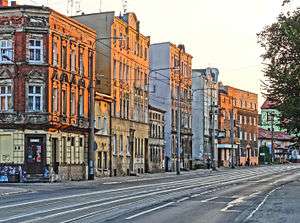Nakielska street in Bydgoszcz
| Bydgoszcz | |
|---|---|
| <span class="nickname" ">Polish: Ulica Nakielska w Bydgoszczy | |
|
View to the west | |
|
Nakielska St. highlighted in red | |
| Former name(s) | Nakelerstraße - Ludendorffstraße[1] |
| Namesake | Nakło nad Notecią |
| Owner | City of Bydgoszcz |
| Length | 5.4 km (3.4 mi) |
| Location | Bydgoszcz, Poland |
| Wikimedia Commons has media related to Nakielska Street in Bydgoszcz. |
Nakielska Street is an important street in Bydgoszcz, Poland. It starts from downtown settlements to the limits of the city towards Nakło nad Notecią.[2]
Location
Nakielska street extends east-west, from Grunwaldzka roundabout and junction with Focha Street to the intersection with Łochowska street near the western border of Bydgoszcz. Its length is about 5.4 km. The street is one of the main thoroughfares leading to the center of Bydgoszcz, connecting the western neighborhoods of the city situated on the south side of Bydgoszcz Canal.
History
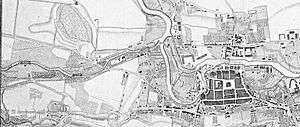
Nakielska Street is an old road connecting Bydgoszcz to Nakło nad Notecią on the west of the city. An early 19th century map of Bromberg shows a path roughly matching today's street, which runs through the several estates: Wilczak, Miedzyń and the "Prondy colony". The path then led through Łochowo, Gorzeń,a bridge on Bydgoszcz Canal's 9th lock to Nakło nad Notecią.[3]
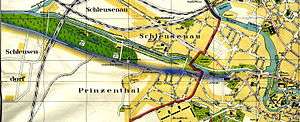
A 1857 map of Bydgoszcz shows the path beginning at the intersection with Holy Trinity Street (then Berliner Strasse) next to the bridge over the canal.[4] In 1872, a railway viaduct was built over the street for the line to Inowrocław (in 1897, the line extended to Żnin and, in 1908, to Poznań). After Bydgoszcz returning to Polish territory in 1920, suburbs (Wilczak and Miedzyń) have been incorporated into the city administrative limits, making Nakielska street almost entirely part of Bydgoszcz. The final part was "acquired" during city border changes in 1954.[5]
By the end of the 19th century, the street was paved, and the first buildings appeared on the eastern section.[6]
The first street modernization after World War II happened only in the 1960s. Bitumen pavement was then applied from the railway viaduct to eastern city limits.[7] In 1973, has been built a roundabout over the filled portion of the old Bydgoszcz Canal, at the connection with Grunwaldska street.[8]
Since 1990, few heavy renovations have been carried out on this thoroughfare, despite many projects and programs.
Communication means
First tramway line on Nakielska street has been built in 1901, for the extension westward of third electric line, line "C" White, launched in 1900 from Theatre Square. Tram tracks were laid from Theatre Square to the crossing between Nakielska street and Czerwonego Krzyża street.[9] In 1950, track lanes have been extended to the railway viaduct.[10]
In addition to the street-car service, a bus line has been working since 1956 along Nakielska street.
The street is one of the heaviest traffic arteries in Bydgoszcz. In 2006, a measurement showed that during peak hours up to 1,100 vehicles were passing every hour. The most crowded section are the Grunwaldska roundabout and the intersection with Widok street.[11]
Buildings
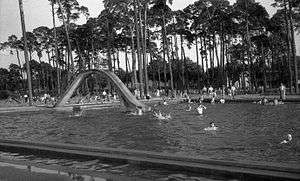
Original buildings on Nakielska street were created on plots leased from farm owners. Modest one-storey houses from the late 19th century were soon replaced by tenement houses, with similar designs to ones in downtown. In 1927 Polish Red Cross, owner since 1921 of a farm plot, established a residential area connected to Nakielska street. This road, formerly named Jary, was then renamed "Czerwonego Krzyża" (Red Cross street). During the Prussian period, many buildings have been built along "Nakelerstrasse", among which:
- The evangelical church of the Divine Mercy,
- A Protestant and a Catholic school,
- The villa at No. 47 (projekt from architect Fritz Weidner),
- The "Factory of Machine Tools for wood" and the associated Villa Carla Blumwe.[12]
During the interwar period, the municipal stadium between the street and the Bydgoszcz Canal has been created, allowing sports activities run by the newly established (April 25, 1920) club "Gwiazda Bydgoszcz" (Bydgoszcz Star).[13] In 1956, on its premises was inaugurated city's largest swimming pool: in a 4 hectares area were laid, among others, an outdoor swimming pool, children's pools, a solarium, changing rooms and food points.[14] The recreation centre ceased its activity in the 1980s. In the vicinity, in 2009, has been built the first marina on the Bydgoszcz Canal.
In 1961, the municipal Council extended the city boundaries to include in the west, inter alia, Miedzyń and Jary districts, making allowances for a few thousand plots allocated to individual construction. This extension allowed the construction of new schools, retail outlets and churches, such as the parish of the Blessed Virgin Mary of Mount Carmel (1980) and Parish Blissful Michael Kozal (1995).
Main places and buildings
Park on the Bydgoszcz Canal
The park is located in the western part of the city just 2 km from the center. It extends on a fairly narrow strip (100–300 m wide), but along a 3 km part of the old Bydgoszcz Canal and Nakielska street, making it the secong largest park in Bydgoszcz (47 hectares).
Its creation is associated with the construction of Bydgoszcz Canal, the oldest in Poland, connecting Noteć and Brda rivers, thus being a link in the long waterway between rivers Oder and Vistula.
The Bydgoszcz canal has been completed in 1774. On the section of Bydgoszcz, it is characterized by the need to overcome a 22 m high level gap, hence the need to build seven locks.[15] Ernst Conrad Peterson was a channel inspector who came with the idea in 1802 to have the banks of the channel planted with trees to stabilize the unstable sandy soil: black poplars, alders, chestnuts, lindens, elms and beeches. In the days of Duchy of Warsaw (1807-1815) Napoleonic General Wincenty Aksamitowski planted rows of trees, today called "William polars", that are recognized as Polish Natural Monument.[15]
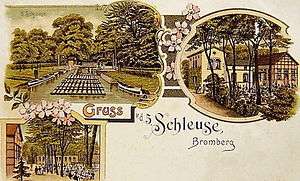
In the second half of the 19th century, the park on the canal became a city-wide leisure and entertainment area: the first restaurant with a dance floor and a garden patio - Blumenschleuse ("the flower lock")- was built in 1838. In following years, private entrepreneurs opened there catering facilities and organized attractions: boat rentals, dances, exhibitions, summer theater, ice rink, etc. In this constant foliage and bushes area was unveiled in 1894 a monument to the co-creator of the canal, Franz von Brenckenhoff, in a form of a bust standing between the second and third lock. It was dismantled and moved to Piła in July 1919, after the decision to reintegrate Bydgoszcz to Polish territory.[16] At the same time the Bydgoszcz Canal, was participating actively to the city business: countless rafts floated to the west, and locks were used age by barges, ships and even steamers.
In 1906-1915, a thorough reconstruction of the Bydgoszcz Canal led to excavate a new section (1.63 km long), with two new locks: consequently, the fraction along Nakielska street became abandoned and was used as a recreational area. This portion of the canal was then called "Old Bydgoszcz Canal". Nevertheless, it remained fully operational and was used twice afterwards: first in 1939, for Polish troops and shortly after World War II while one of the main lock was still out of order.
During interwar period, the park along the canal was a hallmark of Bydgoszcz, must-see in the touristic circuit of the city. Marshal Józef Piłsudski planted there a tree during his short stay in 1921.

A general reconstruction with embellishments was carried out in 1936: in the park, there were a dozen of restaurants, cafes, beer gardens, playgrounds for children, as well as tennis courts, and a 9 ha leisure complex founded in 1928 by Sejm member Idzi Świtała.[15] The grounds were a propicious place for birds, with a lush vegetation: for 150 years, it has been considered as housing one of the largest colony of Thrush nightingales in Europe.[17] Some of the oldest trees were seen as natural curiosities such as a 36 m high black poplar with a trunk circumference of 300–500 cm.[18] The park started to become neglected in the 1960s, with the progressive expansion of Bydgoszcz and the unfavorable socio-economic climate: eventually, the old portion of the Canal became filled with rainwater and wastewater from the western part of the city.[18] In 1970, the decision of the municipal council to dry and fill the eastern section of the canal was the last straw: 624 m of canal, together with two locks and a bridge were destroyed to widen the thoroughfare.[8] This resulted in a decrease of the park area by one third, from 74 to 47 hectares, and for the Old Canal to become a dead branch, detached from Mill Island.
In the 1980s the future of the preserved section of the Old Canal has been questioned: several solutions have been considered, including a complete liquidation of the site. Finally, in the early 1990s, choice has been made to realize an acceptable reconstruction of the locks to clean the channel. A development plan of the Old Bydgoszcz Canal provided for the renovation of hydraulic equipment, the reconstruction of alleys and benches, the construction of playgrounds, and the maintenance of greenery. Three locks were renovated between 1992 and 1995, together with the interdiction of sewage releases, the set up of fountains in the mainstream and the creation of a 4 km long bike path.[18] In 2004, in Nowogrodzka street 3, in a building owned by the High School N°3 "Adam Mickiewicz", has been created the Museum of Bydgoszcz Canal, while since December 8, 2005, the whole area of the Bydgoszcz Canal (New and Old) is registered on Kuyavian-Pomeranian Voivodeship heritage list.[19]
 View of the main stream with fountain on
View of the main stream with fountain on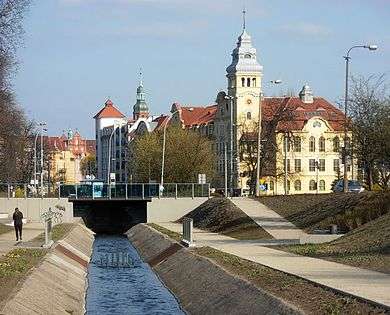 End of open air section
End of open air section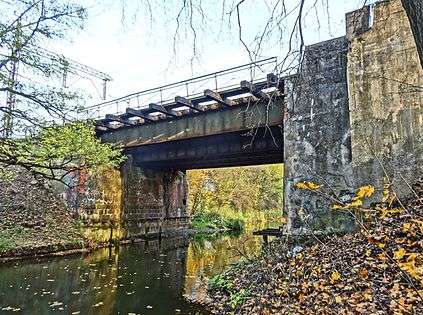 Railway bridge over the canal
Railway bridge over the canal Lock N°4
Lock N°4 Lock N°5
Lock N°5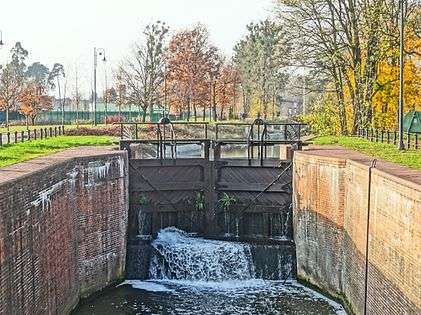 Lock N°6
Lock N°6

Villa Carl Blumwe
The Villa Carla Blumwe is a former industrial building that belonged to factory owners Carl and Wilhelm Blumwe. The building is located at Nakielska street 53 in Bydgoszcz. Its architectural features can be connected with identical industry-related edifices from the second half of 19th century in Lodz and Warsaw.
The construction of the Villa happened in several stages, led by the successful development of the neighbouring "Factory of Machine Tools for wood", on which plot is built the house. The oldest part of the premises is made of wattle and daub was built in the 1850s, while its north façade was erected in 1879, made of bricks as a single-storey building with a separate entrance.
In December 12, 1892, Wilhelm Blumwe applied for the reconstruction and expansion of his a dwelling house. He asked designer Carl Stampehl, a master mason and carpenter, to realize this project. At this time, Carl Stampehl already was known to have designed tenements in Gdańska Street in Bygoszcz at N°16 and N°22. For the villa, Carl Stampehl carried out in 1893:
- the reconstruction of the old house's interior,
- the addition of an attic,
- the building of a columned column porch.
A tower was also added on the western part, along with a new wing devoted to business offices. All architectural details on the facade were revamped, giving an uniformity to the structure. Another building addition was performed in 1900. After World War II, an intensive refurbishing outside and inside has obliterated a major part of architectural details. Throughout its existence, the villa was part of "Factory of Machine Tools for wood".[20] Wilhelm, Carl's son, took over the company in 1887 and successfully developed it until his death in 1903. Wilhelm had his own villa built on Gdańska Street, at N°50 in 1900.
The building design refers to rich neo-Baroque villas. The oldest eastern part has an asymmetrical facade, with a wooden cornice supported by corbels and a wattle and daub wall, filled with ceramic bricks. The brick office building reminds strongly of the industrialists realisations from the end of the 19th century. The southern main entrance is preceded by a porch, only survival a two-column shaped portico. Above the door is placed a cornice, with a cartouche supported by two puttoes. The facade of the tower has bossage stones topped with friezes. Above is set is Mansard roof capped by a bulging, wrought-iron spire.
The villa represents an eclectic style of architecture, with lots of brick and a clear predominance of neo-Baroque elements. The style and richly adorned façade onto the street identified the social position of the family industrialists who owned the villa.[20]
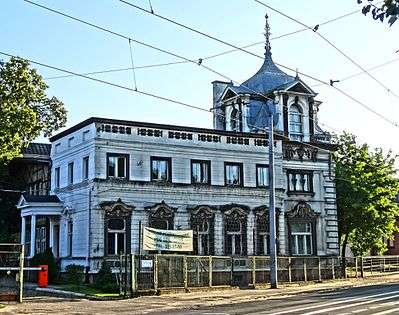 View from Nakielska street
View from Nakielska street Tower and its finial
Tower and its finial Detail of the Mansard roof
Detail of the Mansard roof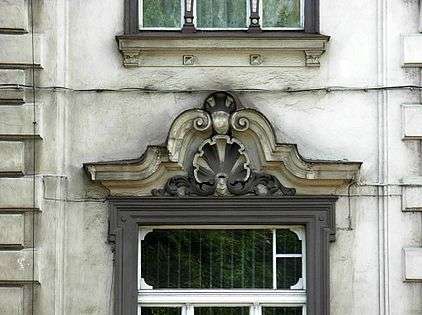 Detail of a pediment
Detail of a pediment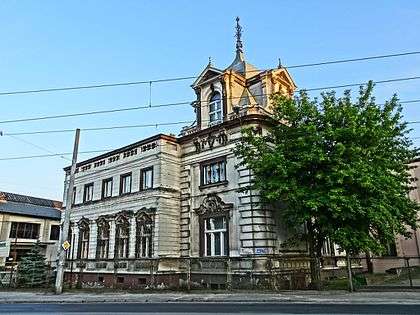 View from Nakielska street
View from Nakielska street
Factory of Machine Tools for wood
History
Fabryka Obrabiarek do Drewna (FOD) is one of the oldest (1865) active Bydgoszcz companies, producing machines and equipment for wood processing, and now also complete technological lines for the wood industry.[21] It is the oldest in Poland company in its sector.[22] It is located at Nakielska street 53. The plot was initially occupied by a paper mill as early as 1802, then welcomed in 1839 the first machine production plant in Bydgoszcz, Plagemann's agricultural equipment factory".[23]
The founder of the company, Carl Blumwe, was born in 1827 in Chojnice and came to Bydgoszcz in 1855.[20] After a stint in railway industry until 1865, he established his own workshop of construction and repair of agricultural machinery, which grew in 1869 and moved to a plot located at Jagiellonska Street 94. Looking for a better location for its plant, Carl Blumwe bought in 1878 a piece of land with buildings from the widow of an iron foundry owner Julius Schmidcie in Wilczak district (now Nakielska St. 53). The same year, the company turned to his son Wihelm who changed its business name to "Carl Blumwe and Son" (German: C. Blumwe & Sohn Eisengießerei in. Special - Fabrik für Patentwagenachsen und Holzbearbeitungsmaschinen). In 1886, the plant employed more than 100 workers, and expanded its production to steam engines.[20]
Built in 1879 then extended in 1905-1917, Bromberg wood harbour contributed significantly to the rapid development of the local timber industry after 1890.[24] The entire local timber industry has developed using the waterway transit to Germany, it employed at its peak activity 6200 people employees and enabled the development of enterprises producing machines and equipment for woodworking.[24] Wilhelm Blumwe modernized its plant with technical improvements and transformed it into a joint stock company in 1897. The company had seats in Berlin, Magdeburg, Cologne, and goods exported, among others, to China, United States and Africa. Wilhelm Blumwe died in 1903.[20] During the interwar period, FOD corporation was incorporated as a subsidiary to the company's Pomeranian Grudziądz Machine Factory SA. In July 1, 1928, Bydgoszcz branch became independent under the name "Factory Thracians and Machines for Metal Woods, formerly C. Blumwe and Son, Sp. Acc. In Bydgoszcz".[20] After the Great Depression, in 1931, the factory employment had fallen to 100 people, to 50 people in 193.[25] The re-development of the factory started up in 1935-1939.[20] After the outbreak of World War II and Nazi occupation of Bydgoszcz, the company was confiscated by the German Central Office Trust - East. They put back the original German company name, i.e. "Fabrik für Holzverarbeitungsmaschinen Blumwe und Co. AG".[26] The factory was militarized, but continued its production of machinery and equipment for the wood industry.
In 1945, in the first days after the liberation Bydgoszcz, the plant resumed its operations. Initially the factory started to produce for the military, but quickly returned to its original production profile, satisfiying the needs of the timber industry.[27] In the years 1950-1955, it was expanded according to the Six-Year Plan, which granted priority to the expansion of heavy industry.[28] In 1970 decision was made to specialize the plant in the production lines for the sawmill industry.[20]
In November 2011, Minister of Finance has announced a public offer for the sale of 85% of the share capital of the company.
Architecture
The factory complex has been built in the second half of the 19th century, to the like of well-known industrial similar buildings in Lodz or Warsaw. Owner's villa has been erected within the plant area. The factory building is connected to the prestigious residential and office, emphasizing the social status of the manufacturer, while at the same time contrasting with the austere, brick-architecture of the factory halls.[20] From the historical ensemble, buildings still preserved to this day are:[20]
- "Carl Blumwe" Villa, in a Neo-Baroque style, used as an office building (1850–1900);
- The assembly hall (1896–1897), with a Neo-gothic facade;
- The lathe ward, now the gatekeeper lodge (1895–1900)
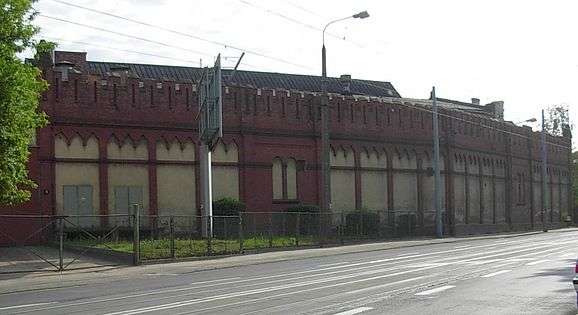 View on the assembly hall from Nakielska street
View on the assembly hall from Nakielska street View from Nakielska street
View from Nakielska street View on the main gate, the lathe ward and part of "Carl Blumwe" Villa
View on the main gate, the lathe ward and part of "Carl Blumwe" Villa
Church of Divine Mercy
The church is located at Nakielska street 68, in Wilczak district, within the area of Bydgoszcz Canal Park. The construction of the church took place in the context of an intensive development of the evangelical church architecture in Bydgoszcz and its suburbs at the end of the 19th century and early 20th century: in this period, eight Evangelical churches were erected in and around Bydgoszcz, mostly in a red-brick neo-Gothic style.[29]
Initially subordinated to Okole parish authority until 1898, the Wilczak evangelical church was established as independent in 1900, covering Wilczak, Miedzyń and part of Prądy districts. The construction of the temple and ancillary buildings on Nakielska happened in 1902-1904, thanks to the efforts of the first parish priest and the parish council composed of influential people.[30] The main architect was Bydgoszcz designer Carl Rose, who has previously realized in the city:
- a residential house in the backyard of Gdanska St.16 (1882),
- his own house at Gdanska St.51 (1903),
- a tenement at Gdanska St.135 (1893).
The erection of the main structure of the church was completed in 1905, and interiors were finished and equipped in 1906. Evangelical service in the temple was carried out until 1945, although the best years for the development of the parish and the church already ended with the outbreak of World War I. The building was devastated when German community left Bydgoszcz during World War II, and on February 2, 1945, municipal authorities handed out the edifice to responsibility of the parish of the Holy Trinity in Bydgoszcz for Catholic use (dedication occurred on June 15, 1945). Cardinal August Hlond issued a decree establishing on October 1, 1946 the Parish of the Divine Mercy (Polish) "Kościół Miłosierdzia Bożego"). Following this decision, the interior of the church was adapted to the Catholic liturgy:
- new decor,
- a new organ,
- a main altar by sculptor Kazimierz Lipinski, with reliefs depicting Jesus of Mercy, Andrew Bobola and Mary Magdalene, set on Dec. 7, 1947,
- two other new altars, one dedicated to Our Lady of the Gate of Dawn and the other to Anthony of Padua, both made by Kazimierz Lipinski,
- five confessionals.
Side upper galleries were removed, except those above the main entrance.
The temple has three aisles, its footprint founded on a Christian cross with enclosed chancel oriented to the north. The main body consists of a vast nave, a long-chancel and a short arms transept. Front of the church is dominated by the massive tower topped with a high pointed dome.[31] Temple's facades are decorated with friezes and pinnacles. The front facade has a portal with reliefs depicting Christ the Good Shepherd, and an above mosaic with the image of Our Lady of Czestochowa, the entrance door remained very decorative, with wrought iron hinges and its lock adorned with vegetable motifs.
 The evangelical temple in 1912
The evangelical temple in 1912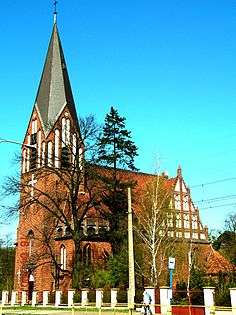 View from Nakielska street
View from Nakielska street The tower
The tower
 Side frontage
Side frontage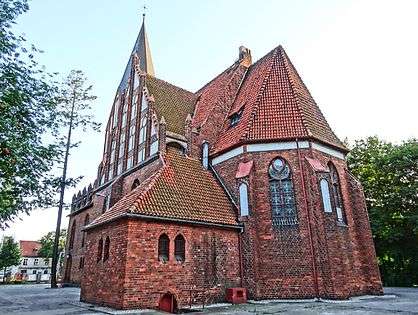 Opposite view
Opposite view- Interior
Other buildings and facades
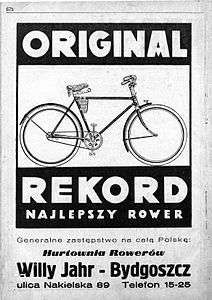 Advert. for Bike Firm at Nakielska 89, ca. 1936
Advert. for Bike Firm at Nakielska 89, ca. 1936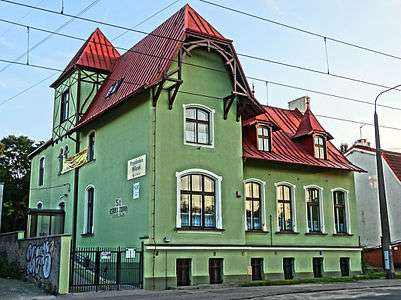 Villa at No. 47 from architect Fritz Weidner
Villa at No. 47 from architect Fritz Weidner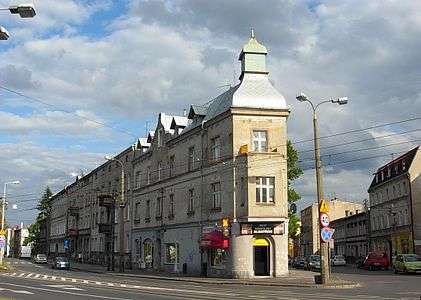 View at Dolina St. intersection
View at Dolina St. intersection- House at N°25 from Nakielska street
 Detail from facade at N°25
Detail from facade at N°25- Building at N°4
- Facade of building at N°75
- Building at N°44
- Detail of facade at N°5
See also
External links
- (Polish) Gwiazda Bydgoszcz
- (Polish) Old canal of Bydgoszcz
- Bydgoszcz Canal Museum
- Factory of Machine Tools for wood
- (Polish) Parish of the Divine Mercy site
Bibliography
- (Polish) Brzozowska Iwona, Derkowska-Kostkowska Bogna: Fabryka Carla i Wilhelma Blumwe na bydgoskim Wilczaku. [w.] Materiały do dziejów kultury i sztuki Bydgoszczy i regionu. Zeszyt 2. Bydgoszcz 1997
- (Polish) Czajkowski Edmund: Na marginesie pewnej informacji.- Kalendarz Bydgoski 1987
- (Polish) Badtke Marek: Kanał Bydgoski: Bydgoszcz, 2006.
- (Polish) Bydgoska Gospodarka Komunalna. Praca zbiorowa. Bydgoszcz 1996. ISBN 83-85860-37-1.
- (Polish) Kaja Renata. Bydgoskie pomniki przyrody. Instytut Wydawniczy "Świadectwo". Bydgoszcz 1995. ISBN 83-85860-32-0.
- (Polish) Kuczma Rajmund. Zieleń w dawnej Bydgoszczy. Instytut Wydawniczy "Świadectwo". Bydgoszcz 1995.
References
- ↑ Jurkiewicz, Zenon (1994). Bydgoskie ulice. Bydgoszcz: Kalendarz Bydgoski.
- ↑ Kuczma, Rajmund (2005). Mała encyklopedia Bydgoszczy - liteda "D". Bydgoszcz: Kalendarz Bydgoski.
- ↑ Karte von Ost-Preussen nebst Preussisch Litthauen und West-Preussen nebst dem Netzdistrict aufgenommen unter Leitung des Preuss. Staats Minister Herrn von Schroetter in den Jahren von 1796 bis 1802
- ↑ Plan von Bromberg und Umgegend zwischen der Weichsel und Netze sowie den Königl. Oberförstereien Wtelno u. Glinke. Berlin 1857, skala 1:25000
- ↑ Licznerski, Alfons (1965). Rozwój terytorialny Bydgoszczy. Bydgoszcz: Kronika Bydgoska II.
- ↑ Bydgoszcz w stronę Okola. Bydgoszcz: Zespół Pracowni Dokumentacji i Popularyzacji Zabytków Wojewódzkiego Ośrodka Kultury w Bydgoszczy. 2004. ISBN 83-921725-0-7.
- ↑ Kajczuk, Jacek (1996). Ulice i place. Bydgoszcz: Bydgoska gospodarka komunalna. ISBN 83-85860-37-1.
- 1 2 Kulesza, Maciej. "Zasypali Stary Kanał, bo zwiększał się ruch samochodowy". bydgoszcz.wyborcza.pl. Wyborxza pl. Retrieved 6 June 2016.
- ↑ Rasmus, Hugo (1996). Od tramwaju konnego do elektrycznego. Bydgoszcz: Kronika Bydgoska XVII.
- ↑ Dębicki, Witold (1996). Komunikacja miejska. Bydgoszcz: Bydgoska gospodarka komunalna. ISBN 83-85860-37-1.
- ↑ Fundacja "Rozwój ATR" (2006). Generalny pomiar cech ruchu drogowego na sieci komunikacyjnej miasta Bydgoszczy. Bydgoszcz: Bydgoszcz.
- ↑ Gordon, Wincenty (1971). Bydgoskie dzielnice – Wilczak (Wielki). Bydgoszcz: Kalendarz Bydgoski.
- ↑ Urbanyi Zbigniew, Smoliński Zbigniew (1970). Bydgoszcz jako ośrodek sportowy. Bydgoszcz: Kronika Bydgoska III.
- ↑ Umiński, Janusz (1996). Bydgoszcz. Przewodnik. Bydgoszcz: Regionalny Oddział PTTK "Szlak Brdy". p. 142.
- 1 2 3 Kuczma, Rajmund (1995). Zieleń w dawnej Bydgoszczy. Bydgoszcz: Instytut Wydawniczy "Świadectwo".
- ↑ "Brenckenhoff stał nad kanałem". pomorska.pl. 20 August 2009. Retrieved 17 July 2015.
- ↑ Kuczma, Rajmund (1995). Zieleń w dawnej Bydgoszczy. Bydgoszcz: Instytut Wydawniczy "Świadectwo". p. 82.
- 1 2 3 Jastrzębski, Włodzimierz (2011). Encyklopedia Bydgoszczy. t.1. Bydgoszcz: Towarzystwo Miłośników Miasta Bydgoszczy. p. 314. ISBN 978-83-926423-3-6.
- ↑ N°601440, Reg.A/900/1-27, Nov. 30th 2005
- 1 2 3 4 5 6 7 8 9 10 Brzozowska Iwona, Derkowska-Kostkowska Bogna (1997). Fabryka Carla i Wilhelma Blumwe na bydgoskim Wilczaku. Bydgoszcz: Materiały do dziejów kultury i sztuki Bydgoszczy i regionu. Zeszyt 2.
- ↑ "Fabryka Obrabiarek do Drewna". fod.com.pl. DyalCom. 2013. Retrieved 6 June 2016.
- ↑ http://www.fod.com.pl/ dostęp 24-02-2010.
- ↑ Bydgoszcz Guide. Bydgoszcz: City of Bydgoszcz. July 2014. p. 22. ISBN 83-917786-7-3.
- 1 2 Sławińska, Krystyna (1969). Przemysł drzewny w Bydgoszczy i w okolicy w latach 1871-1914: Prace Komisji Historii t. VI. Bydgoszcz: Bydgoskie Towarzystwo Naukowe. Prace Wydziału Nauk Humanistycznych. Seria C.
- ↑ Biskup, Marian (1999). Historia Bydgoszczy. Tom II cz. 1 1920-1939. Bydgoszcz: Bydgoskie Towarzystwo Naukowe. p. 123. ISBN 83-901329-0-7.
- ↑ Biskup, Marian (2004). Historia Bydgoszczy. Tom II cz. 2 1939-1945. Bydgoszcz: Bydgoskie Towarzystwo Naukowe. p. 245. ISBN 83-921454-0-2.
- ↑ Michalski, Stanisław (1988). Bydgoszcz wczoraj i dziś 1945-1980. Bydgoskie Towarzystwo Naukowe, Państwowe Wydawnictwo Naukowe Warszawa-Poznań. p. 64.
- ↑ Michalski, Stanisław (1988). Bydgoszcz wczoraj i dziś 1945-1980. Bydgoskie Towarzystwo Naukowe, Państwowe Wydawnictwo Naukowe Warszawa-Poznań. p. 75.
- ↑ Derkowska-Kostkowska Bogna, Winter Piotr (1998). Z historii zboru ewangelickiego na Wilczaku. Bydgoszcz: Kalendarz Bydgoski.
- ↑ M.in. Mertens – sekretarz kolei, Liptau – jeden z członków zarządu dzielnicy.
- ↑ Parucka, Krystyna (2008). Zabytki Bydgoszczy – minikatalog. "Tifen". Bydgoszcz: Krystyna Parucka.
Coordinates: 53°07′52″N 17°56′53″E / 53.1310°N 17.9481°E
